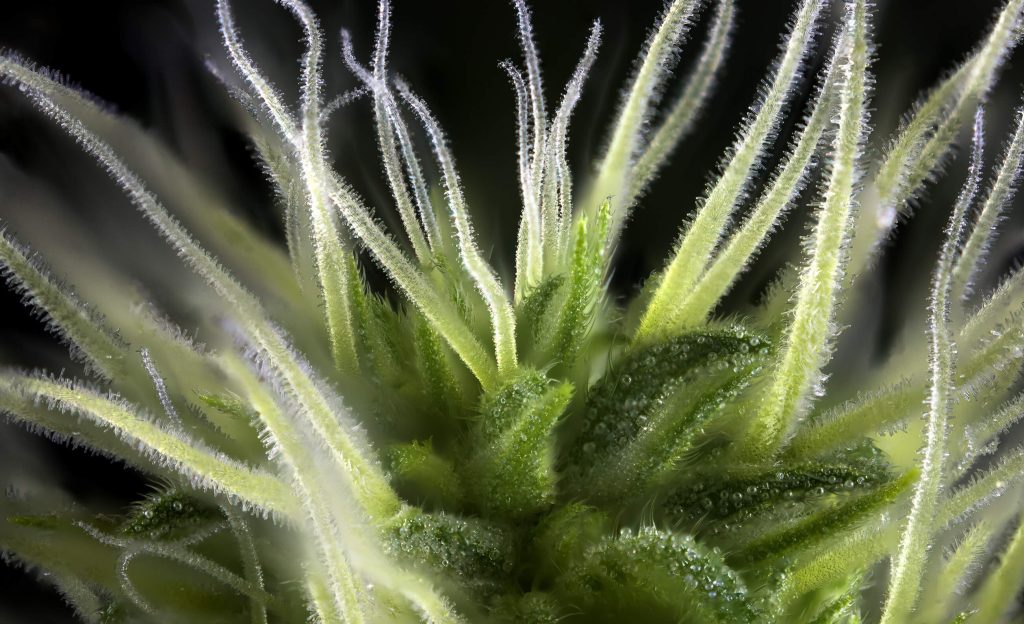Pistils play a vital role in the anatomy and reproductive system of the cannabis plant. Their function is to facilitate pollination. As the plant matures, the pistils change from a white colour to shades of orange, red, or brown. Observing the pistils lets you determine the plant’s maturity and identify the right time for harvesting. So, let’s explore more!
What is a pistil?


Pistils are one of the most fascinating parts of the female cannabis plant, and they serve as the starting point for the reproductive process. The pistil consists of three main parts: the stigma, the style, and the ovary. These hair-like structures develop at the nodes, where branches meet the main stem. As the plant matures, pistils change from white to orange or brown, which is helpful for growers looking to harvest when the cannabinoid and terpene levels peak.
So, let’s take a closer look at the functions of each component:
What is a stigma?


Often mistaken for pistils, a stigma is a part of the pistil responsible for receiving pollen and is located at the top. Its sticky texture is meant to capture pollen glands to enable the production of seeds.
What is a style?


The style is a long stalk that connects the stigma to the ovary and is essential for pollination. It facilitates the transfer of pollen from the male reproductive organ to the female reproductive organ.
What is an ovary?


The ovary is located at the base of the pistil and contains the ovules needed for pollination. It protects and produces the ovules, which combine with male gametes to form seeds.
What is the role of pistils in cannabis?
The pistil is an essential part of the cannabis plant, as it plays a crucial role in pollination and reproduction. During the pollination process, the male plants release pollen that the female plants intercept through wind or insects. The sticky stigma of the pistil captures the pollen grains, which then travel down the style and fertilise the ovules in the ovary. This fertilisation process leads to the development of seeds, which are essential for the continuation of the cannabis species.


In the wild, the pollination process occurs naturally, but in commercial cannabis cultivation, growers often separate male and female plants to control the pollination and prevent the growth of seeds. This is because seed production can reduce the quality and potency of the cannabis flower. By separating male and female plants, growers can ensure that female plants produce high-quality, seedless flowers rich in cannabinoids and terpenes.
When do pistils appear?


Pistils are a sign that your plants are entering the pre-flowering stage. Photoperiod strains begin to show pistils once growers switch to a 12/12 lighting schedule, or naturally outdoors as daylight shortens. It is important to note that pistils may take up to 10 days to appear after the initiation of flowering. For autoflowering varieties, the first pistils typically develop around 3 to 4 weeks after germination.
What colours do pistils turn?
As cannabis plants progress through their life cycle and begin to flower, the colour of their pistils will start to change. These pistils can change from white to orange, red, or brown, depending on the state of maturity. Some strains may display vibrant reds and oranges due to anthocyanins, which are pigments that can be influenced by environmental factors such as temperature and light. But don’t necessarily indicate a specific stage of maturity.
Pistils during early stages of flowering: white hairs on weed
During the beginning of the flowering stage, the pistils on cannabis plants will appear white. This is because they are still immature and developing. Harvesting the plants at this stage is not recommended to allow them to mature and reach their full potential.
Pistils during mid-stage of flowering: orange and red hairs on weed
Around four weeks into flowering, pistils will typically turn from white to orange or red, reaching maturity. To maximise the cannabinoid and terpene content, this is the time to harvest. Waiting too long can result in a loss of potency and flavour.
Pistils during the late stages of flowering: brown hairs on weed
Towards the end of flowering, the pistils will develop an amber hue, a sign that the cannabis plant has completed its job of reproducing seeds. If you see brown hairs, harvest plants as soon as possible, as you have missed the peak window for cannabinoid and terpene content.
When to harvest in coordination with pistils


While it’s true that harvesting before the pistils turn amber is a good rule of thumb, there are additional factors to consider. Pay attention to the colour of the trichomes. These resin glands contain the compounds responsible for the plant’s effects. Use a jeweller’s loupe to examine the colours of them. It’s best to harvest when the trichomes are around 80% cloudy or milky but not yet amber or brown, as cannabinoid content degrades as the trichomes mature.
Appreciating the beauty of pistils
Cannabis pistils play an essential role in the development of the plant and provide valuable information on its maturity and potency. Without these tiny hairs, we couldn’t reproduce the strains we grow in our gardens today. By understanding the colours of the pistils it helps growers to produce high-quality cannabis. Whether you are a beginner grower or a cannabis enthusiast, paying attention to the pistils can enhance your experience and appreciation of this fantastic plant.
-
Disclaimer:Laws and regulations regarding cannabis cultivation differ from country to country. Sensi Seeds therefore strongly advises you to check your local laws and regulations. Do not act in conflict with the law.
- SEO Powered Content & PR Distribution. Get Amplified Today.
- PlatoData.Network Vertical Generative Ai. Empower Yourself. Access Here.
- PlatoAiStream. Web3 Intelligence. Knowledge Amplified. Access Here.
- PlatoESG. Carbon, CleanTech, Energy, Environment, Solar, Waste Management. Access Here.
- PlatoHealth. Biotech and Clinical Trials Intelligence. Access Here.
- Source: https://sensiseeds.com/en/blog/cannabis-pistils-what-are-those-hairs-on-weed/



